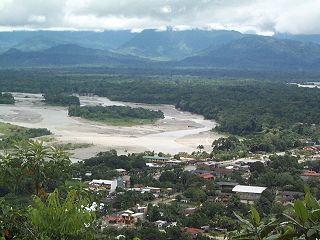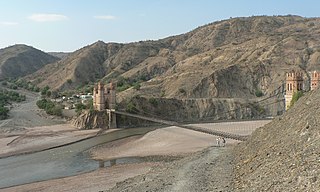
Chapare (Spanish:[tʃaˈpaɾe], also called The Chapare, is a rural province in the northern region of Cochabamba Department in central Bolivia. Most of the territory consists of valley rainforests that surround the area's main waterway, the Chapare River, which is also a tributary of the Amazon River. The provincial capital is Sacaba, 11 km east of Cochabamba. Its principal town is Villa Tunari, a popular tourist destination.

Arani is a province in Cochabamba Department, Bolivia. Its capital is Arani, situated about 53 km from Cochabamba. Arani is known for its bread and its artisan wickerwork.

Esteban Arze is a province in Cochabamba Department, Bolivia. Its capital is Tarata. Many people from the Esteban Arze province have migrated abroad,mainly to Argentina and to the Washington DC area https://pulitzercenter.org/reporting/only-bridge-matters-now

Cornelio Saavedra is a province in the north-eastern parts of the Bolivian Potosí Department. The capital of the province is Betanzos with 4,168 inhabitants in the year 2001.

José María Linares is a province in the eastern parts of the Bolivian department of Potosí. Its capital is Puna.

Sacaba is a capital city and a municipality in the Bolivian province of Chapare. The city, located 13 kilometers eastward from Cochabamba, is the second largest city in the Cochabamba Department after Cochabamba city. Post-colonial architecture may be seen in the inner part of Sacaba; however, some has been destroyed due to lack of municipal care.

Vacas Municipality is the second municipal section of the Arani Province in the Cochabamba Department in central Bolivia. Its capital is Vacas known as the "Land of the potato". During the Inca Empire Vacas served as a tampu along the Inca road system that led to Inkallaqta and Pocona.
Tiraque Municipality is the first municipal section of the Tiraque Province in the Cochabamba Department, Bolivia. At the time of census 2001 - still including Shinahota Canton - it had a population of 35,017. Its seat is Tiraque.

Rocha River or Kunturillu River which upstream is called Mayllanku(Maylanco) is a Bolivian river in the Cochabamba Department, Quillacollo Province. From the point of the confluence with the Arque River the river is called Caine River.
Anzaldo Municipality is the second municipal section of the Esteban Arce Province in the Cochabamba Department, Bolivia. Its seat is Anzaldo. At the time of census 2001 the municipality had 9,126 inhabitants.

Sacabamba Municipality is the fourth municipal section of the Esteban Arce Province in the Cochabamba Department, Bolivia. Its seat is Sacabamba. At the time of census 2001 the municipality had 4,718 inhabitants.

Mizque Municipality is the first municipal section of the Mizque Province in the Cochabamba Department, Bolivia. Its seat is Mizque.

Tinguipaya Municipality is the first municipal section of the Tomás Frías Province in the Potosí Department in Bolivia. Its seat is Tinguipaya.

Yocalla Municipality is the second municipal section of the Tomás Frías Province in the Potosí Department in Bolivia. Its seat is Yocalla.
Jorge Ledezma Cornejo is a Bolivian lawyer and politician affiliated with the Movement towards Socialism–Political Instrument for the Sovereignty of the Peoples. Ledezma served as a Deputy in the lower house of the Bolivian National Congress, representing circumscription 28, and as interim prefect of Cochabamba from December 2008 until 30 May 2010. He is currently Bolivia's ambassador to Peru. His career began as vice president of Cochabamba's Departmental Irrigation Users Federation in 1997; leader of the Mega (Sacaba) Association of Irrigation Users in 1998; and president of the Vigilance Committee of the Municipality of Sacaba in 1998. He then won public office as a councilman in Sacaba in 1999, followed by serving as the city's mayor in 2000-2001. His appointment to Prefect of Cochabamba was made by President Evo Morales following the 100-day tenure of Rafael Puente; the reasons for Puente's replacement are disputed.
Pukara Mayu is a Bolivian river in the Cochabamba Department, Chapare Province, Sacaba Municipality. It is a left affluent of Mayllanku River (Maylanco) which receives the name Rocha River when it enters the Cochabamba Municipality.

Warawara, often spelled Wara Wara, is a lake in the Tunari National Park in Bolivia. It is located in the Cochabamba Department, Chapare Province, Sacaba Municipality. Warawara lies north east of the city Cochabamba and north of Alalay Lake. The lake is situated 4,105 metres (13,468 ft) high. It is 0.8 km long and 0.5 km at its widest point.

The association football tournament at the 2018 South American Games was held from 27 May to 5 June in Cochabamba, Bolivia.

Handball competition of the 2018 South American Games in Cochabamba were held from May 27 to June 6 at the Coliseo Municipal Curubamba in the municipality of Sacaba, it qualified two places in both genders to the 2019 Pan American Games.
The 2019 Sacaba massacre occurred when Bolivian soldiers and police attacked and broke up a protest led by Bolivian coca growers at Huayllani in Sacaba municipality, Cochabamba on 15 November 2019. It came in the first week of the interim presidency of Jeanine Áñez. Marchers intended to enter the town of Sacaba and proceed to the departmental capital of Cochabamba to protest the ousting of Bolivian president Evo Morales, but were stopped by the police and military. During the afternoon, police and soldiers clashed with protesters, and eventually soldiers opened fire on the crowd. Eleven demonstrators were killed; an estimated ninety-eight people were wounded, including four journalists and eight members of the security forces. Two hundred twenty-three protesters were arrested, many of whom suffered mistreatment and at least nine of whom were tortured.

















